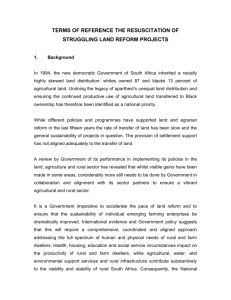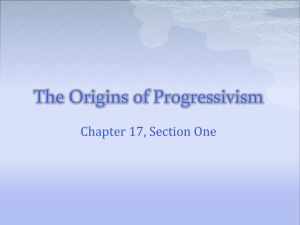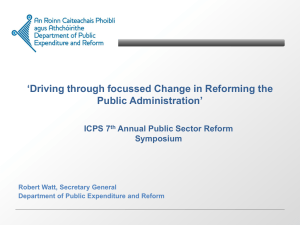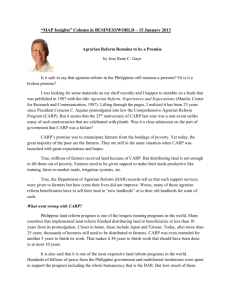Overview of Land Rights in Inda - The Greens | European Free
advertisement
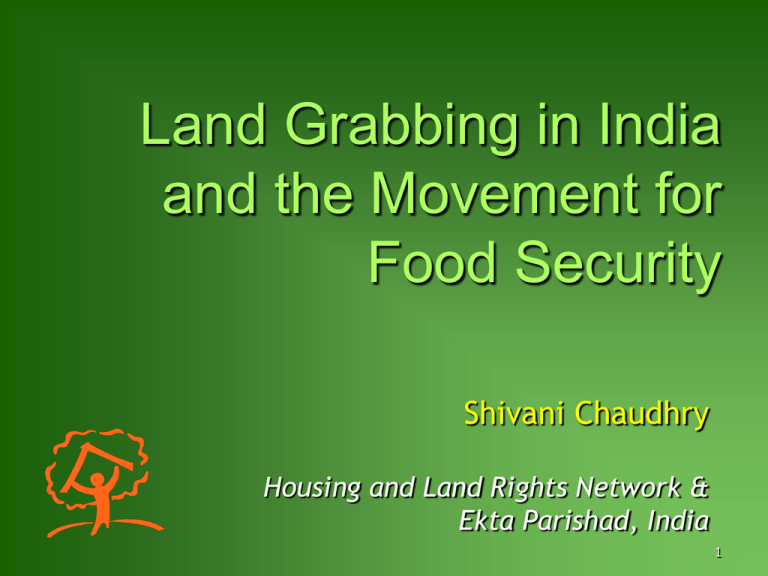
Land Grabbing in India and the Movement for Food Security Shivani Chaudhry Housing and Land Rights Network & Ekta Parishad, India 1 India: Socio-Economic Indicators One-fifth of world’s poor live in India – the largest for any country. India has one-fourth (208 million) of world’s 800 million under-nourished people. Child malnutrition is the world’s highest. Human Development Index: 119 of 169 countries. GDP growth rate: +7% over 3 years. 2 Land Distribution & Ownership India is 70% rural with high dependence on land: agriculture, fisheries and forests. 83% of farmers are small farmers <2 hectares. Small farmers produce 41% of country’s food grains. 60% of cultivable land owned by 10% of population. 3 Land Distribution & Ownership Unequal ownership of land – root cause of poverty & hunger. Landless and ‘near-landless’ ~ 220 million people. 90% of landless poor are Scheduled Castes (Dalits) & Scheduled Tribes (indigenous peoples). Majority work as agricultural labour and sharecroppers. Access to land is a key determinant of food security and livelihood protection. 4 Women & Land Rural women depend greatly on land for subsistence. Perform > 50% of all agricultural work. 35% of rural households are women-headed, but less than 2% women hold titles to land. Migration of men to urban areas – resulting in ‘feminisation of agriculture.’ Women largely not recognised as farmers. 5 Land Reform Post-independence land reform focused on: Abolition of system of feudal landlords (zamindars). Tenancy reforms to transfer ‘land to the tiller.’ Redistribution of land via ‘ceiling’ on holdings. 6 Failure of Land Reform Land reform not successfully implemented in most states. No focus on gender equity. 2 million acres of land declared surplus but not yet distributed because of litigation /other reasons. Post-1991: pro-liberalisation agenda. Push for removal of land ceiling restrictions. No political will to implement land reform. Draft Twelfth Five Year Plan (2012-2017): does not mention land reform. 7 What is ‘Land Grabbing’? Phenomenon of takeover of people’s land by both State and non-State actors. Generally forceful / involuntary. Largely unregulated/ illegal/ without due process. Often justified with ‘public purpose’ clause. People generally left with no legal recourse/ access to remedy. Occurring at an unprecedented scale in rural and urban areas. 8 Land Grabbing: Key Factors (1) ‘Development projects’ – dams, mining, natural resource extraction, ports, roads, infrastructure projects, mega-events… Special Economic Zones (1 million face threat of eviction). Slum demolitions/ ‘urban renewal.’ India is estimated to have the highest number of people displaced annually as a result of ‘development’ projects: since independence (1947) almost 65 million displaced 9 Land Grabbing: Key Factors (2) Industrialization of agriculture. Reduction in agricultural subsidies. High prices of patented /GM seeds & fertilisers. Bio-fuel production (3.2 million hectares). Creation of carbon stocks for ‘climate mitigation.’ National Parks/ Eco-tourism. 10 Land Grab Facilitated by : (1) Use of Land Acquisition Act (1894) which allows state takeover of land under guise of ‘public purpose.’ Neo-liberal economic policies and obsession with ‘GDP growth.’ Changes in land laws to facilitate conversion of agricultural land and to ease land sale. 11 Land Grab Facilitated by: (2) Manipulation of laws and takeover of land by the state for companies (Indian and foreign), often using violence: State acquiring land for foreign investors under leasing arrangements – e.g. Vedanta Aluminium/ Lafarge. 6,000 acres land acquired for Yamuna Expressway in Uttar Pradesh (1,225 villages) – 4 farmers killed in clashes. POSCO (South Korea) Steel Plant, Odisha: state using police force to suppress resistance / destroy betel vines / threaten villagers. 12 Land Grab Facilitated by: (3) Alienation of tribal lands. Violation of ‘ceiling’ laws in rural areas. Failure to implement progressive laws: Panchayat (Extension to Scheduled Areas) Act, 1996. Forest Rights Act, 2008. Failure to implement positive court orders. Lack of human rights-based laws and policies (e.g. Rehabilitation Policy). 13 Urban Land Grab Caused by: Unplanned urbanization. Repeal of Urban Land (Ceiling & Regulation) Act. Inequitable land use policies : lack of space for urban poor in cities/towns. Unchecked real estate speculation. Absence of housing, health, employment schemes for the urban poor. 14 Trade & Investment Agreements: India has signed 21 bilateral investment treaties with 22 of 27 EU states. EU-India FTA: ‘investor protection chapter’ - conflicts with human rights obligations. Risk of takeover of community land for large-scale investment by European companies. Obligation of Fair and Equitable Treatment (FET) – against human rights /no ‘public interest’ exemption. ‘Free and Prior Informed Consent’ not required. Lease of 99 years – could interfere with land reform. Investor-State dispute settlement – gives foreign investors undue rights over Constitution of India & int’l law. 15 Impacts of Land Grabbing (1): Increased forced evictions : 40-50% of displaced are tribal/ indigenous peoples. Increasing landlessness/ homelessness. Acute agrarian crisis. Growing indebtedness of farmers. Rise in farmer suicides (+ 250,000 in 15 years). Forced migration to urban areas. Deepening poverty and hunger. 16 Impacts of Land Grabbing (2): Arbitrary arrests /attacks/ detention of human rights defenders. Criminalisation of social movements . Social unrest and violence: rise of insurgency and counter-insurgency movements. Disproportionately severe impacts on women. Violation of multiple human rights. 17 Movement of Small Peasants People uniting to struggle against forceful land acquisition and corporate agriculture. Growth of organic farming & small farmer cooperatives. Women leading movements to occupy village ‘wastelands’ & promote collective farming/ rights. Non-violent social movements like Ekta Parishad are mobilising thousands and spreading awareness on the importance of land reform and redistribution to promote food security, self-governance and dignity. 18 Recommendations for Govt. of India (1) Adopt a strong human rights approach in all laws/policies/programmes. Implement human rights-based agrarian reform => land redistribution + agricultural resources (including seeds), water, information, & access to markets. Adopt urban reform measures + provision of homestead land in urban areas. Provide legal security of tenure & recognise collective rights. Strengthen National Land Reforms Council. Strengthen Public Distribution System (PDS). 19 Recommendations for Govt. of India (2) Accord women equal rights to land and other natural resources, property, housing, inheritance. Control real estate speculation. Repeal Land Acquisition Act (1894). Develop a comprehensive National Land Reform Policy. 20 Recommendations for Govt. of India (3) Implement good laws: Panchayat Act (1996) & 73rd Amendment Act – devolves powers to local self governing bodies. Forest Rights Act (2008). Directives on joint registration of land – names of men & women. Hindu Succession Amendment Act 2005 - equal inheritance rights for men & women. Enforce: International human rights law. Concluding Observations of UN treaty bodies & Special Rapporteurs. 21 Recommendations for EU (1) Ensure strong human rights protection clause is included in the EU-India FTA. Call for Human Rights Impact Assessments to be conducted ex-ante and ex-post – for all trade & investment agreements (requested by European Parliament in November 2010). Call for implementation of guidelines proposed by Special Rapporteur on right to food regarding land acquisitions & the UN Basic Principles and Guidelines on Development-based Evictions and Displacement. 22 Recommendations for EU (2) Issue guidelines for European investors in India that ensure protection of human rights. EU and India should respect rights of urban and rural poor, and protect small farmers and informal workers. Use Universal Periodic Review (UPR) of India at the Human Rights Council (May 2012) to promote the realisation of human rights to food/land in India. 23 Conclusion Guaranteeing rights of people to own, control and manage their land and other natural resources is critical to promoting food security and well-being, and to protecting multiple human rights 24




